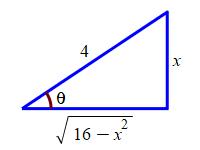7. Trigonometric Substitutions
On the previous page, we looked at tangent substitutions with coefficients. We now look a sine and secant substitutions with coefficients.
b2. Substitutions for \(a^2x^2-b^2\)
If the integrand involves the quantity \(b^2-a^2x^2\) (or \(a^2x^2-b^2\))
and you know that \(|x| \le \dfrac{b}{a}\), then it may be useful to make
a substitution so that \(a^2x^2=b^2\sin^2\theta\). To do this,
\(x=\dfrac{b}{a}\sin\theta\). (This is where you need
\(|x| \le \dfrac{b}{a}\).) Then \(dx=\dfrac{b}{a}\cos\theta\,d\theta\) and:
\[\begin{aligned}
b^2-a^2x^2
&=b^2-b^2\sin^2\theta=b^2(1-\sin^2\theta) \\
&=b^2\cos^2\theta
\end{aligned}\]
So it may be possible to re-express the
integrand in terms of \(\sin\theta\) and \(\cos\theta\) only.
If the integrand involves the quantity \(a^2x^2-b^2\) (or \(b^2-a^2x^2\))
and you know that \(|x| \ge \dfrac{b}{a}\), then it may be useful to make
a substitution so that \(a^2x^2=b^2\sec^2\theta\). To do this,
\(x=\dfrac{b}{a}\sec\theta\). (This is where you need
\(|x| \ge \dfrac{b}{a}\).) Then \(dx=\dfrac{b}{a}\sec\theta\tan\theta\,d\theta\)
and:
\[\begin{aligned}
a^2x^2-b^2
&=b^2\sec^2\theta-b^2=b^2(\sec^2\theta-1) \\
&=b^2\tan^2\theta
\end{aligned}\]
So it may be possible to re-express the
integrand in terms of \(\tan\theta\) and \(\sec\theta\) only.
How do you know if \(|x| \le \dfrac{b}{a}\) or \(|x| \ge \dfrac{b}{a}\)?
You look at any quantities inside square roots such as \(\sqrt{b^2-a^2x^2}\)
which needs a \(\sin\) substitution or \(\sqrt{a^2x^2-b^2}\) which needs a
\(\sec\) substitution. If there is no square root, then you look
at the limits on the integral, if any.
Frequently, it is even easier to check whether \(\,x=0\,\) is an allowed
value.
If it is, then use a \(\sin\) substitution.
If not, then use a \(\sec\) substitution.
Compute \(\displaystyle \int \dfrac{1}{\sqrt{4x^2-1}}\,dx\).
We need \(4x^2-1 \ge 0\) which means \(|x| \ge \dfrac{1}{2}\). So we substitute \(x=\dfrac{1}{2}\sec\theta\). Then \(dx=\dfrac{1}{2}\sec\theta\tan\theta\,d\theta\) and: \[\begin{aligned} \int \dfrac{1}{\sqrt{4x^2-1}}\,dx &=\int \dfrac{1}{\sqrt{\sec^2\theta-1}}\dfrac{1}{2}\sec\theta\tan\theta\,d\theta \\ &=\dfrac{1}{2}\int \dfrac{1}{\sqrt{\tan^2\theta}}\sec\theta\tan\theta\,d\theta =\dfrac{1}{2}\int \sec\theta\,d\theta \\ &=\dfrac{1}{2}\ln|\sec\theta+\tan\theta|+C \end{aligned}\] To substitute back, we already know that \(\sec\theta=2x\) from the definition of the substitution. We also need a formula for \(\tan\theta\) in terms of \(x\). We can find it from the Pythagorean identity \(\tan^2\theta=\sec^2\theta-1\). Then \[ \tan\theta=\sqrt{\sec^2\theta-1}=\sqrt{4x^2-1} \]
Or we can draw a right triangle with hypotenuse \(2x\) and adjacent side \(1\), so that \(\sec\theta=\dfrac{2x}{1}=2x\). Then the opposite side is \(\sqrt{4x^2-1}\) and \(\tan\theta=\dfrac{\sqrt{4x^2-1}}{1}=\sqrt{4x^2-1}\).

Returning to the problem at hand, we conclude: \[ \int \dfrac{1}{\sqrt{4x^2-1}}\,dx =\dfrac{1}{2}\ln\left|2x+\sqrt{4x^2-1}\right|+C \]
We check by differentiating. If \(f(x)=\dfrac{1}{2}\ln\left|2x+\sqrt{4x^2-1}\right|\), then \[\begin{aligned} f'(x) &=\dfrac{1}{2}\dfrac{1}{2x+\sqrt{4x^2-1}}\left(2+\dfrac{1}{2}\dfrac{8x}{\sqrt{4x^2-1}}\right) \\ &=\dfrac{1}{2x+\sqrt{4x^2-1}}\left(\dfrac{\sqrt{4x^2-1}+2x}{\sqrt{4x^2-1}}\right) =\dfrac{1}{\sqrt{4x^2-1}} \end{aligned}\] which is the integrand we started with.
Compute \(\displaystyle \int_0^2 \dfrac{1}{x^2-16}\,dx\).
From the limits, we know \(0 \le x \le 2\). So \(|x| \le 4\). So we substitute \(x=4\sin\theta\). Then \(dx=4\cos\theta\,d\theta\) and: \[\begin{aligned} \int_0^2 \dfrac{1}{x^2-16}\,dx &=\int_{x=0}^2 \dfrac{1}{16\sin^2\theta-16}4\cos\theta\,d\theta \\ &=\dfrac{1}{4}\int_{x=0}^2 \dfrac{\cos\theta}{-\cos^2\theta}\,d\theta =-\,\dfrac{1}{4}\int_{x=0}^2 \sec\theta\,d\theta \\ &=\left[-\,\dfrac{1}{4}\ln|\sec\theta+\tan\theta|\right]_{x=0}^2 \end{aligned}\]
To substitute back, we know \(\sin\theta=\dfrac{x}{4}\). So we draw a right triangle with opposite side \(x\) and hypotenuse \(4\), so that \(\sin\theta=\dfrac{x}{4}\). Then the adjacent side is \(\sqrt{16-x^2}\). Consequently, \[ \tan\theta=\dfrac{x}{\sqrt{16-x^2}} \quad \text{and} \quad \sec\theta=\dfrac{4}{\sqrt{16-x^2}} \]

Returning to the problem at hand, we conclude: \[\begin{aligned} \int_0^2 \dfrac{1}{x^2-16}\,dx &=\left[-\,\dfrac{1}{4}\ln\left|\dfrac{4+x}{\sqrt{16-x^2}}\right|\right]_0^2 \\ &=-\,\dfrac{1}{4}\ln\dfrac{4+2}{\sqrt{16-2^2}}+\dfrac{1}{4}\ln\dfrac{4}{\sqrt{16}} \\ &=-\,\dfrac{1}{4}\ln(\sqrt{3}) \end{aligned}\]
When we see the expression \(x^2-16\), we normally think we should use a \(\sec\) substitution. However in this case, the limits on the integral say differently.
Compute \(\displaystyle \int \dfrac{1}{\sqrt{4-9x^2}}\,dx\)
Let \(3x=2\sin\theta\)
\(\displaystyle \int \dfrac{1}{\sqrt{4-9x^2}}\,dx =\dfrac{1}{3}\arcsin\dfrac{3x}{2}+C\)
Let \(9x^2=4\sin^2\theta\) or \(x=\dfrac{2}{3}\sin\theta\). Then \(dx=\dfrac{2}{3}\cos\theta\,d\theta\) and \[\begin{aligned} \int \dfrac{1}{\sqrt{4-9x^2}}\,dx &=\int \dfrac{1}{\sqrt{4-4\sin^2\theta}}\dfrac{2}{3}\cos\theta\,d\theta \\ &=\dfrac{1}{3}\int \dfrac{1}{\sqrt{\cos^2\theta}}\cos\theta\,d\theta =\dfrac{1}{3}\theta+C \\ &=\dfrac{1}{3}\arcsin\dfrac{3x}{2}+C \end{aligned}\]
We check by differentiating. If \(f(x)=\dfrac{1}{3}\arcsin\dfrac{3x}{2}\) then \[ f'(x) =\dfrac{1}{3}\dfrac{1}{ \sqrt{1-\dfrac{9x^2}{4}} }\dfrac{3}{2} =\dfrac{1}{\sqrt{4-9x^2}} \] which is the integrand we started with.
Compute \(\displaystyle \int \dfrac{1}{\sqrt{9x^2-4}}\,dx\)
Let \(3x=2\sec\theta\).
\(\displaystyle \int \dfrac{1}{\sqrt{9x^2-4}}\,dx =\dfrac{1}{3}\ln\left|\dfrac{3x}{2}+\dfrac{\sqrt{9x^2-4}}{2}\right|+C\)
Let \(9x^2=4\sec^2\theta\) or \(x=\dfrac{2}{3}\sec\theta\). Then \(dx=\dfrac{2}{3}\sec\theta\tan\theta\,d\theta\). So: \[\begin{aligned} \int \dfrac{1}{\sqrt{9x^2-4}}\,dx &=\int \dfrac{1}{\sqrt{4\sec^2\theta-4}}\dfrac{2}{3}\sec\theta\tan\theta\,d\theta \\ &=\dfrac{1}{3}\int \dfrac{\sec\theta\tan\theta}{\sqrt{\sec^2\theta-1}}\,d\theta =\dfrac{1}{3}\int \dfrac{\sec\theta\tan\theta}{\sqrt{\tan^2\theta}}\,d\theta \\ &=\dfrac{1}{3}\int \sec\theta\,d\theta =\dfrac{1}{3}\ln|\sec\theta+\tan\theta|+C \end{aligned}\]
To substitute back, we know \(\sec\theta=\dfrac{3x}{2}\). So: \[\begin{aligned} \tan\theta&=\sqrt{\sec^2\theta-1} =\sqrt{\dfrac{9x^2}{4}-1} \\ &=\dfrac{\sqrt{9x^2-4}}{2} \end{aligned}\] Or we can look at the triangle and conclude \(\tan\theta=\dfrac{\sqrt{9x^2-4}}{2}\).

Then: \[\begin{aligned} \int \dfrac{1}{\sqrt{9x^2-4}}\,dx &=\dfrac{1}{3}\ln\left|\dfrac{3x}{2}+\dfrac{\sqrt{9x^2-4}}{2}\right|+C \\ &=\dfrac{1}{3}\ln\left|3x+\sqrt{9x^2-4}\right|-\dfrac{1}{3}\ln 2+C \end{aligned}\]
We check by differentiating. If \(f(x)=\dfrac{1}{3}\ln\left|3x+\sqrt{9x^2-4}\right|\), then \[\begin{aligned} f'(x) &=\dfrac{1}{3}\dfrac{1}{3x+\sqrt{9x^2-4}} \left(3+\dfrac{9x}{\sqrt{9x^2-4}}\right) \\ &=\dfrac{1}{3x+\sqrt{9x^2-4}}\left(\dfrac{\sqrt{9x^2-4}+3x}{\sqrt{9x^2-4}}\right) =\dfrac{1}{\sqrt{9x^2-4}} \end{aligned}\] which is the integrand we started with.
For each of the following integrals, choose which substitution to make.
\(x=\dfrac{4}{3}\sin\theta\) \(x=\dfrac{4}{3}\sec\theta\) \(x=\dfrac{3}{4}\sin\theta\) \(x=\dfrac{3}{4}\sec\theta\)-
\(\displaystyle \int_{1/4}^{1/3} \dfrac{1}{16-9x^2}\,dx\)
A. Correct
To get the coefficients to match, we need \(x=\dfrac{4}{3}\sin\theta\) or \(x=\dfrac{4}{3}\sec\theta\).
Since \(\dfrac{1}{4} \le x \le \dfrac{1}{3}\), we have \(x \lt \dfrac{4}{3}\). So \(x=\dfrac{4}{3}\sin\theta\).B. Incorrect
Look at the limits.C. Incorrect
To get the coefficients to match, we need \(9x^2=16\sin^2\theta\) or \(9x^2=16\sec^2\theta\).D. Incorrect
To get the coefficients to match, we need \(9x^2=16\sin^2\theta\) or \(9x^2=16\sec^2\theta\).
Also, look at the limits. -
\(\displaystyle \int_{1/4}^{1/3} \dfrac{1}{16x^2-9}\,dx\)
A. Incorrect
To get the coefficients to match, we need \(16x^2=9\sin^2\theta\) or \(16x^2=9\sec^2\theta\).B. Incorrect
To get the coefficients to match, we need \(16x^2=9\sin^2\theta\) or \(16x^2=9\sec^2\theta\).
Also, look at the limits.C. Correct
To get the coefficients to match, we need \(x=\dfrac{3}{4}\sin\theta\) or \(x=\dfrac{3}{4}\sec\theta\).
Since \(\dfrac{1}{4} \le x \le \dfrac{1}{3}\), we have \(x \lt \dfrac{3}{4}\). So \(x=\dfrac{3}{4}\sin\theta\).D. Incorrect
Look at the limits. -
\(\displaystyle \int_{3}^4 \dfrac{1}{9-16x^2}\,dx\)
A. Incorrect
To get the coefficients to match, we need \(16x^2=9\sin^2\theta\) or \(16x^2=9\sec^2\theta\).
Also, look at the limits.B. Incorrect
To get the coefficients to match, we need \(16x^2=9\sin^2\theta\) or \(16x^2=9\sec^2\theta\).C. Incorrect
Look at the limits.D. Correct
To get the coefficients to match, we need \(x=\dfrac{3}{4}\sin\theta\) or \(x=\dfrac{3}{4}\sec\theta\).
Since \(3 \le x \le 4\), we have \(x \gt \dfrac{3}{4}\). So \(x=\dfrac{3}{4}\sec\theta\). -
\(\displaystyle \int_{3}^4 \dfrac{1}{9x^2-16}\,dx\)
A. Incorrect
Look at the limits.B. Correct
To get the coefficients to match, we need \(x=\dfrac{4}{3}\sin\theta\) or \(x=\dfrac{4}{3}\sec\theta\).
Since \(3 \le x \le 4\), we have \(x \gt \dfrac{4}{3}\). So \(x=\dfrac{4}{3}\sec\theta\).C. Incorrect
To get the coefficients to match, we need \(9x^2=16\sin^2\theta\) or \(9x^2=16\sec^2\theta\).
Also, look at the limits.D. Incorrect
To get the coefficients to match, we need \(9x^2=16\sin^2\theta\) or \(9x^2=16\sec^2\theta\).
Heading
Placeholder text: Lorem ipsum Lorem ipsum Lorem ipsum Lorem ipsum Lorem ipsum Lorem ipsum Lorem ipsum Lorem ipsum Lorem ipsum Lorem ipsum Lorem ipsum Lorem ipsum Lorem ipsum Lorem ipsum Lorem ipsum Lorem ipsum Lorem ipsum Lorem ipsum Lorem ipsum Lorem ipsum Lorem ipsum Lorem ipsum Lorem ipsum Lorem ipsum Lorem ipsum